Cricket - A Bat & Ball Game
Overview
Cricket is a team sport that is played outdoors. Cricket originated in England and gradually became popular across the globe. This sport requires complete physical fitness and athleticism to play. The sport is played between two teams of 11 players each.
Australia is the current World Champion (2015). Countries like India, Pakistan, England, South Africa, New Zealand, West Indies, and Sri Lanka also have equally dominant cricket teams.
Objective
Cricket is played outdoors on the ground. The objective of the game is that a team should score more runs than the opponent team. It is all about attempting to score more runs while restricting the score and dismissing the batsmen of the opponent team. Further in the document, one can closely understand the game, its popular terms, and rules.
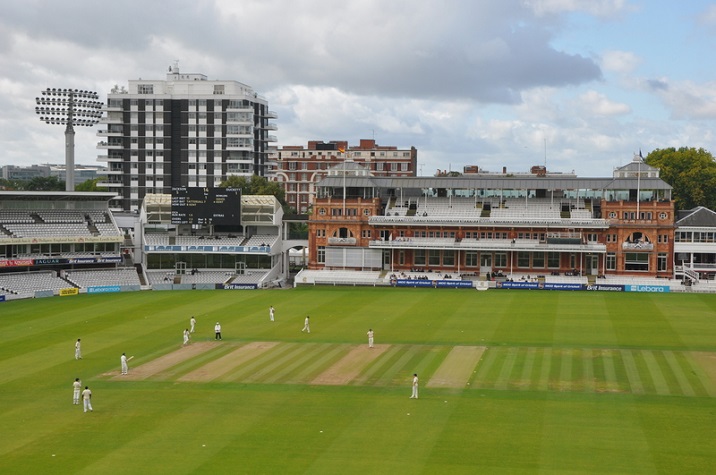
Team Size
In cricket, each playing side has 11 players and one of them is appointed as captain. Apart from these 11 players, there are a few more players on each side who can only field as a substitute for an injured team member. The fielding team should have 11 players and the opposition can send only two batsmen on the ground at the time of play.
A 15-member squad is a must for all international tournaments conducted by the cricket’s governing body, International Cricket Council (ICC).
Cricket - Participating Countries
Cricket as a sport began in England. The evidence available leads us to believe in south-east England at the beginning of the 1900s. During those days, Australia, South Africa, and West Indies were the other countries where the sport was played. Gradually, the sport picked up popularity in the Asian continent as well. India, Pakistan, Sri Lanka, Bangladesh also started playing the sport.
Asian Countries Participating in Cricket
In the late 1900s, Asian countries like India, Sri Lanka, and Pakistan have made a mark in world cricket with each winning World Cup once. It led to the founding of the Asian Cricket Conference in 1983 that took charge of developing the sport in the rest of Asia. By the 21st century, Bangladesh had become a new force in Asian cricket. Nepal, Malaysia, and Afghanistan also play competitive cricket now. Amongst these three nations, Afghanistan made headlines by qualifying for the World Cup in 2014.
The Asian Cricket Conference was renamed Asian Cricket Council in 2003, headquartered in Kuala Lumpur. The council is subordinate to ICC and has an association of 25 countries.
Non-Asian Countries Participating in Cricket
England, Australia, West Indies, and South Africa started playing cricket in the early 20th century. It was the brain of Abe Bailey, the then President of South Africa Cricket Association, to form an international council. Imperial Cricket Conference was formed in 1906 that was later renamed as International Cricket Council. Zimbabwe, Kenya, Ireland, Netherlands, Canada, Scotland, and UAE have all been part of international tournaments for over two decades. The United States also adopted the game in the last few years. Currently, there are more than 100 countries playing this sport and associated with ICC.
International cricket is played in three formats. A five-day match called Test match; same-day match comprising 50-over a side called One-day International; and 20-over a side called T-20 International are the three formats. T-20 is the latest and the most popular format over the last five years.
Cricket - Playing Environment
Cricket is a team sport and is played on a big ground. The pitch in the center and ground is prepared for any format of the match. Later, stumps are rooted along the breadth of the pitch, and players are called on to the ground to start the play. The team fielding will have 11 players guarding the boundary and two batsmen from the opposition will come to bat. There will be two umpires on the field to monitor the match proceedings.
Cricket Field Dimensions
The sport is played on presumably a circular leveled ground with pitch as the center. The pitch is 24-yards in length and 4-yards in breadth. A rope is placed around the ground at a distance of 80 yards from the pitch. This rope is observed as a boundary. The stumps are rooted at both ends with a distance of 22-yards between them. Two carved small pieces of wood are placed on stumps, called bails. White parallel lines are drawn on both ends of stumps, called batting/bowling crease. It is 1.2 meters from stumps. Another set of parallel lines are drawn perpendicular to the batting crease, called the return crease. This is at a distance of half-meter from the length of the pitch.
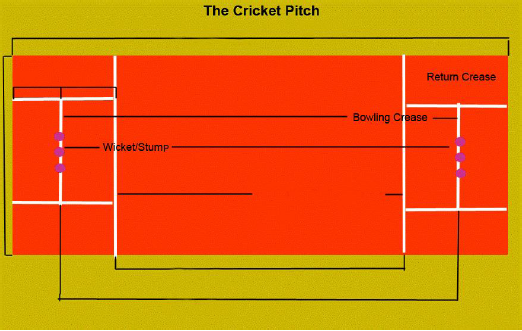
Dimensions of Cricket Equipment
ICC has formed certain rules for cricket equipment along with the rules of play. The bat, ball, glove, pads, and all other equipment have to meet the standards set by the governing body. It’s not only the size of equipment but also the logos used on the equipment that should conform to the standards set by ICC. Given below is a list of cricket equipment with permissible measures −
Bat − A cricket bat should not be more than 38 inches in length and 4.25 inches wide.
Ball − The cricket ball must weigh between 155.9 and 163 g. Apart from weight, the circumference should be between 224 and 229 mm.
Keeper glove − The keeper glove doesn’t have specific measurements but should not be made of stretchable material. The glove has webbing between the thumb and the index finger.
The rest of the equipment is all used to protect body parts, hence there aren’t any specific measures or design standards, with safety as a priority.
Cricket - Equipment
As cricket is a game of bat and ball, the players are subjected to wear protective gear to not getting hurt. In this chapter, we will discuss all the important gear and equipment that the players use while playing the game.
Bat − Bat is a nicely carved piece of equipment made out of special wood, with a handle on top to hold and play. These vary in weight and size with age and requirement of the batsman. |  |
Ball − It is a spherical object made out of cork and covered with leather. Two pieces of leather are stitched around the cork ball. The color of the ball for test matches is red and white for ODI and T20 matches. |  |
Keeper Glove − These are worn on both hands to protect the fingers from injury. Cloth and leather are stitched together in the shape of the fingers and palm to fit exactly. The inner side of the glove has finger gaps with cork tips for more protection. | 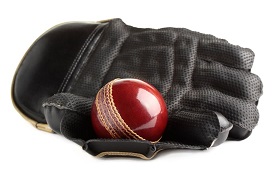 |
Batsman Glove − This gear is similar in shape but smaller and softer on the outer part when compared to the keeper glove. It is used to hold the bat firmly. The finger part of the glove has extra protection with a hard sponge on the outer area. |  |
Keeper/Batsman Pads − These are worn to protect the lower limbs of the batsman/keeper. They are made of cloth and leather. The front portion of the pads is very hard as there are hard plastic or wood sticks beneath. The rear portion is spongy and soft to soothe and comfort the legs. Keeper pads are a little shorter than batsman pads. | 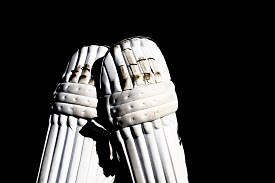 |
Helmet − A headgear for the batsman/keeper while batting or wicket-keeping behind the stumps. It is a mix of metal and hard plastic. It has a metallic grill in the front to protect the face. |  |
Stumps − These are cylindrical and long in shape with a shard end like a spear. This end goes into the ground so that stumps stand erect in the ground. | 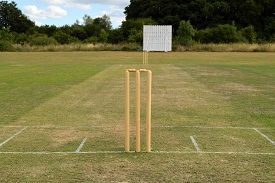 |
Bails − Bails are the smallest equipment placed on stumps. It helps in giving easy decisions by umpires to dismiss the batsman when the wicket is broken.
Popular Terms in cricket
By now, you must have got the hang of terms like a batsman, bowler, umpire, stumps, etc. Now, let’s know the terms used at play.
Striker − A batsman facing the bowler is a caller striker and the opposite end is called a non-striker.
Off-side/leg-side − One half of the ground is called off-side and the other side is called leg-side. From the perspective of a right-handed batsman, the pitch in front of his body as he takes a strike, i.e. the right side of the pitch is called off-side. Similarly, the left half of the pitch, i.e. the pitch behind his body while taking a strike is called leg-side.
Run − It is the basic unit of scoring in cricket. It is scored when a striking batsman hits the ball bowled and runs between the stumps along with a non-striker. It is usually scored in ones, twos, and threes.
Four − The ball hit by the batsman crosses the boundary rope by rolling on the ground. Then, it is called a boundary or four runs.
Six − The shot that ensures the ball lands directly outside the rope is called six or six runs are allotted to the batsman.
No-ball − If a bowler’s foot crosses the popping crease while delivering the ball then, it is called a no-ball. The ball bowled that is directed above the waist of the batsman without pitching on the ground is a no-ball too.
Wide − A ball that is bowled away from the batsman and moves wide of the return crease on the off-side at the batting end is called wide. Another definition is a ball bowled that bounces over the head of the batsman after pitching is also called wide.
Out − When a batsman gets out, it gives an opportunity to the next person on the batting side to play until 10 players out of 11 are dismissed in various ways. Bowled, Caught, Run-out, LBW, and Stumped are the most common ways of getting out.
Bowled − It is a way of getting out where the batsman misses the ball bowled and the stumps behind are disturbed.
Caught − A batsman is declared out when the fielder catches the ball on full that is hit by the batsman. If it is caught by the wicket-keeper then, it is called caught-behind.
LBW − LBW stands for a leg-before wicket. A batsman is declared out as lbw when he tries to play the ball with the body that is directed on to stumps.
Run-out − If a fielder disturbs the stumps with the ball in hand while the batsman is not increased after playing a shot, then the batsman is declared run-out.
Stumped − A batsman moves out of the crease to play a ball and misses, the keeper gathers the ball and hits the stumps with the ball in hand. Then, the batsman is declared out as stumped.
Spin bowling − Bowlers run a short distance from stumps and release the ball with the use of wrist or fingers to get maximum revolutions. The ball tossed in the air spins after pitching. Off-break and leg-break are two varieties of spin bowling.
Fast bowling − Bowlers sprint and deliver the ball at high speed to batsmen. To do so, they take long run-up from stumps. Slow-medium, medium-fast, and fast are the popular fast bowling varieties.
Extra runs − All the runs given by the fielding team where the batsmen have not hit the ball with the bat are considered as extra runs. For example, wide, no-ball, etc.
Innings − A session of batting and bowling where either the batting team is all-out or the permissible number of overs to be bowled by the fielding team is completed.
How to Play Cricket?
Cricket is a game that requires physical agility to bat, bowl, and field. Two teams of 11 players each play at one time. A set of rules were designed for the game by ICC. These are the same for both men and women players. The game begins with captains of both teams and the match's referee gathering for a toss. The toss winning captain is allowed to elect to bat/field first. This process is the same across all formats. However, the dress code and fielding restrictions vary by format. It is mandatory for players to wear all white for a Test match, and colored tees and trousers for ODI and T20.
Umpires have a key role in the game as they monitor the proceedings. They decide whether the batsman is out, decide on no-ball, wide, and ensure both teams are playing according to the rules.
In this section, we will understand a few laws of the game and how a cricket match is played. The cricket game begins with the on-field umpire’s signal “Let’s play!”
Scoring
Manual and electronic scoring is done during the match to avoid any errors.
The scoring is done on a cumulative basis. All the runs scored with a bat, extra runs like no-ball, wide, etc. are added to the team’s total.
In some instances, on-field umpires find it tough to give few decisions like boundaries, out, no-ball, etc. Therefore, they seek the help of another umpire, called third-umpire.
The third-umpire looks at video visuals and gives a final decision.
Cricket - Formats
In the golden era, cricket was played for days as each team almost played more than 100 overs a day. We can relate that to the current format of Test cricket. In the early days of cricket, an over-involved eight legal deliveries. Gradually, new formats and rules came into existence and an over was reduced to six legal deliveries across all formats. We’re going to discuss the different formats of professional cricket in this chapter and a few rules about them.
Test Cricket
Test cricket is considered the format of the highest level as it required both mental and physical strength to excel. All players wear white tees and trousers for this format. A red cricket ball is used to play. The earliest format of test cricket was played for six days with a day as a reserve. The field restrictions are quite different compared to limited-overs cricket.
Teams A and B have to play two innings each, if necessary. 90 overs are to be bowled every day. Team A batting first scores X runs. Team B gets to bat if team A declares their innings or is all-out. Team B should score X or more runs to stand a good chance of winning the match. Then, team A gets to bat for the second time and sets a target for team B. Now, Team B has to achieve the target in the time left and overs to be bowled.
In the case of team B gets all-out during the chase in the second innings, team A is declared winner, else the match is drawn between the teams.
One-Day International
One-day international (ODI) is limited over the format of cricket. It was introduced in the 1980s and 60 over a side were bowled. The dress code was the same as that of test cricket. Over the years, this format also went through drastic changes in rules and it was reduced to 50 over a side and colored uniform. The red-ball was replaced with a white-ball.
Team A batting first had to set a target for team B in 50 overs. Batting second, team B had to chase down the target in the same number of overs. If they fail to do so, team A is declared as the winner irrespective of team A bowling out team B or not.
T20 International
T20 is the latest and the most successful format of cricket. It has attracted a lot of spectators to the ground and witnessed the match. Cricket became a widespread game in this format and new countries like the United States, Malaysia, Canada, and the Netherlands adapted to it swiftly. It originated in the Caribbean islands, West Indies. Each team gets to play 20-over aside. Since it is the shortest format of the game, it is played under floodlights.
Batting first, team A sets a target for team B in 20 overs. Team B has to achieve the target in their stipulated number of overs while batting second.
Team B is declared the winner if they achieve the target else, team A is declared victorious. Team A is declared the winner even if they restrict team B from scoring the required number of runs and don’t get themselves bowled-out.
Cricket - Tournaments
ICC is the supreme governing body of all the international cricket events and tours. All the international teams are ranked based on their performance in a calendar year. Ranking for cricket teams is based on their progress during international events and tours. These ranks are assigned individually for each format.
Currently, there are 10 test playing nations that are eligible for all three formats. The rest of the countries have to play qualification rounds for entry into international events like the ODI World Cup and T20 World Cup. The World Cup is conducted at senior and under-19 levels.
Test status is given to a national team depending on the performance at the domestic level and global events. We will look at champions of different formats in the last chapter. Here is a list of all the global events organized recently by ICC and multiple nations participate for the ultimate trophy.
| Tournament Name | Venue |
|---|---|
| T20 World Cup 2015 | India |
| ODI World Cup 2015 | Australia, New Zealand |
| ICC Champions Trophy 2013 | England, Wales |
| ICC U-19 World Cup 2014 | UAE |
| ICC Women’s World Cup 2013 | India |
The venue for all the international events is finalized by ICC based on its facilities, playing area standards, and security measures.
All the cricket playing nations have their individual bodies that manage cricket events at the domestic level. The domestic level matches are also played as one-day and five-day games. The one-day games at the domestic level are called List-A and the five-day format is called First-class. Best players are picked from the domestic tournaments to represent the country at the highest level. These national cricket boards also manage venues when another national team is touring their country. They are responsible for visiting the player’s facilities and security.
The following table illustrates the domestic tournaments with respect to country and format.
| Tournament Name | Country | Format |
|---|---|---|
| Ranji Trophy | India | Five-day |
| Challenger Trophy | India | One-day |
| Big Bash League | Australia | T20 |
| The Sheffield Shield | Australia | Five-day |
| English County Cricket | England | Five-day |
| Caribbean T20 League | West Indies | T20 |

0 Comments
Post a Comment